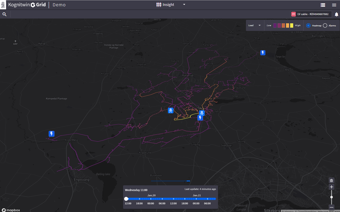Identify processes and work activities for improvement
Incorporating new technology into existing ways of working can be a challenge. New tech is exciting, but we all know the feeling of technology shyness – especially with industrial software as rich as Kognitwin, our digital twin technology that creates a virtual model of your facility to both model and predict asset behaviors.
With that in mind, here’s an insightful tip to help streamline your digital twin journey and apply digital ways of working in the areas where it matters most: by taking the time to identify existing processes and work activities for improvement, digital twin technology can help introduce new ways of working to address specific user pain points. Whether you have yet to start your digital transformation or already implemented a twin but struggle to achieve widespread adoption, identifying how technology can elevate existing ways of working through capabilities that are already available in the digital twin is a promising approach that can lead to net benefits including significantly reduced CAPEX and OPEX expenditure.
Why is it so important to focus on processes?
It can be hard to fully understand the extent to which digital twin capabilities can be applied to the various disciplines in an organization but by simply taking the time to understand the typical work activities of each role, we can identify areas where a digital twin has the potential to:
- Save time in perpetuity by streamlining process steps, thereby lessening the number of human hours needed
- Align technology solutions with business processes to better support organizational goals
- Reduce staff presence on-site by enabling remote execution of some processes
- Drive employee adoption of new technology initiatives by fundamentally changing how (and where) work is done
- Create safer working conditions by supporting planning activities, especially for more hazardous processes
- Reduce expenditure across the value chain by identifying strategic areas for more sustainable behaviors

To unlock these benefits, it helps to get an overview of where technology can help teams work more efficiently and how this aligns with the tools and features available in the digital twin. For example, think about a maintenance technician onsite who receives a weekly maintenance plan of work packs, typically in a list view in an ERP system.
The technician has some work coming up and needs to familiarize themselves with the scope and associated hazards, so the first step is gathering the necessary information. They’ll likely go through an exhaustive, time-consuming process of looking into several systems – like starting from an ERP system, then moving on to a Permit to Work system, a Document Management System, and any other system that holds the countless drawings, isolation plans, historical permits, and documents that need to be reviewed. These documents need to be gathered and sorted in a way that makes sense, and if the information there isn’t enough, the technician might need to schedule a physical site visit to take measurements and understand the risks involved (for example, working at height on a piece of equipment).
Just by focusing on this one workflow, we understand what the technician needs to do – and can identify three major pain points that could be solved with digital twin technology:
- The maintenance plan and information gathered isn’t always visual, making it difficult for the technician to really understand what the work will require and how the information is connected.
- Resources for planning are scattered, and collecting the right information and documents takes up a lot of valuable time.
- The technician might have to do a physical site visit, which requires extra time, effort, and assistance from external resources, all of which can delay maintenance timelines and add up to significant amounts of spending.
Once these pain points are identified, we can see exactly where digital twin technology has the potential to transform a maintenance technician’s current way of working.
- Instead of jumping around between systems, a digital twin is a single industrial work surface where the technician can visualize what the worksite looks like in both 2D and 3D, with the ability to navigate around the facility and zoom in on any piece of equipment.
- Resources are available within a single system in the cloud and the technician can access everything from P&ID diagrams to historical records and maintenance schedules in one place, saving countless hours usually dedicated to gathering and sorting information.
- With the ability to take measurements virtually and execute end-to-end workflows within the twin, technicians can do tasks virtually where they might have previously relied on physical site visits to gather and understand the same information.
What is the net benefit of identifying and trying to improve work activities?
Just like in this example with our maintenance technician, defining processes and identifying the most urgent challenges helps us understand where digital twin technology can solve pain points for discipline-specific and inter-disciplinary workflows. By applying digital twin technology to optimize these existing ways of working, the net benefits of reduced CAPEX and OPEX can be unlocked by significantly reducing the number of resources and human hours necessary to execute everyday workflows.
In one KDI case study, identifying the process of work permit planning and applying our digital twin Kognitwin reduced the amount of time necessary for planning by nearly 50%. Watch the full webinar.
Digital twin technology creates the possibility of having just one environment, a single industrial work surface where:
- All of the documents, drawings, and diagrams have been collected and even better, contextualized so that the user understands what the data means
- Users can get an instant visual overview of areas with existing work orders and maintenance requirements right down to the piece of equipment that needs servicing
- Technicians can leverage the ability to do remote site walks and take measurements of heights and distances
- Teams can collaborate on work planning activities digitally in the same system, from any location in the world
Together, these benefits can be leveraged to identify best practices and optimize overall production in terms of efficiency, resource allocation, safety, and sustainability. Taking the time to identify room for improvement in processes and workflows can help embed best practices for digital ways of working and ensure that users interact with technology in a way that makes it more valuable to their specific role and everyday work life. It is also an actionable way to build up digital competency in the team and most importantly, ensures that the digital twin is embedded into new ways of working to ensure a better tomorrow – for the individual and the organization.

